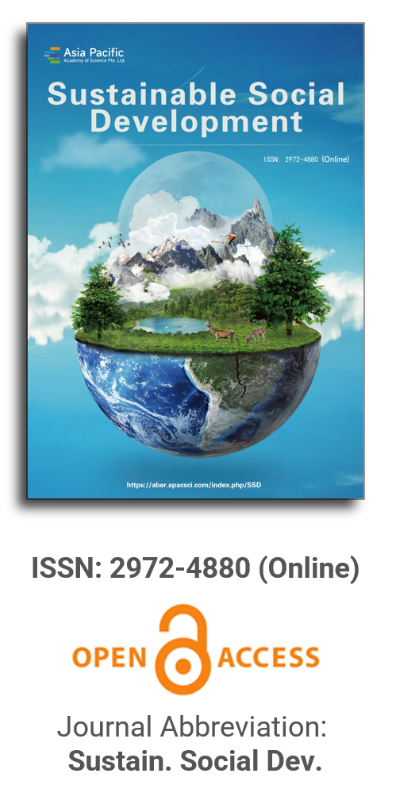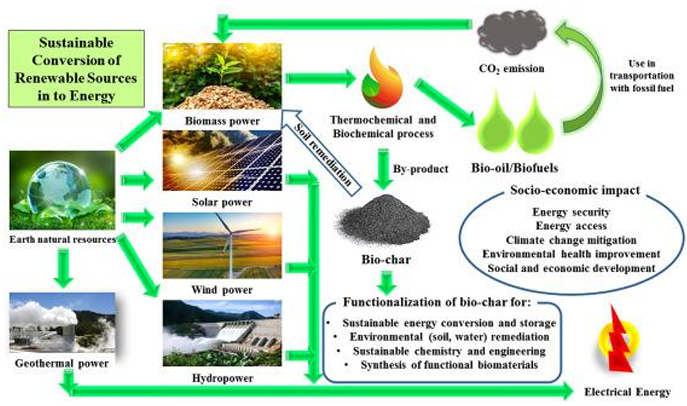
Asia Pacific Academy of Science Pte. Ltd. (APACSCI) specializes in international journal publishing. APACSCI adopts the open access publishing model and provides an important communication bridge for academic groups whose interest fields include engineering, technology, medicine, computer, mathematics, agriculture and forestry, and environment.

Volume 2, Issue 3 of the journal, Sustainable Social Development, covers a range of research topics related to the challenges and solutions for achieving social sustainability. The focus is on how different social, environmental, and demographic factors impact sustainable development. This issue provides a multifaceted look at the social, environmental, and spatial dimensions of sustainable development, highlighting both challenges and potential solutions through empirical research across different geographic contexts. The diversity of topics reflects the complex and interdisciplinary nature of achieving sustainable social progress.
Full Issue
| View or download the full issue |
Issue release: 30 June 2024
Plastic waste and microplastics are invading lands and oceans, creating problems for animals, human health, and the environment. Packaging, building and construction, textiles, and cosmetic sectors are the main industries that utilize these non biodegradable materials. Thus, there is a necessity to find a new way of producing and consuming skin- and eco-compatible’ goods. For this purpose, it’s important to remember that the cosmetic and diet supplement markets are continually increasing, due also to the introduction of “Beauty from within,” based on the contemporary consumption of cosmeceuticals applied to the skin and nutraceuticals taken by oral route. Moreover, both of these products are made by emulsions or solutions based on a great consumption of water with the use of carriers rich in chemicals, which often cause allergy and sensitization problems. Thus, the proposed solution to use smart tissue carriers, which are embedded with natural ingredients, is based on the use of raw materials and biopolymers obtained from food and agroforestry waste. These new carriers, with a structure similar to the Extra Cellular Matrix, may be used to realize smart cosme-nutraceuticals useful to reduce water consumption, producing innovative products free of emulsifiers, preservatives, colors, fragrances, and other chemicals. So, it will be possible to save human health and the environment by maintaining natural raw materials and the biodiversity of the earth for future generations.
Issue release: 30 June 2024
Taita Hills are one of the most important biodiversity hotspots of Kenya but are experiencing a high rate of deforestation due to the to the conversion of its original forestland to agriculture and settlement during the last century. These landscape dynamics, coupled with rainfall fluctuations in these critical ecosystems, may significantly affect water resource distribution and food security in Taita Taveta County and its environs. This study aimed to establish the trends of land use/cover change (LUCC) in the Wundanyi catchment from 1970 to 2030 and predict their specific and combined effects on surface runoff and stream flow in the same period. The analysis was based on statistical trend analysis and dynamic landscape modeling using both historical and primary data from the Wundanyi catchment and Landsat TM and ETM+ imagery of Taita Hills for 1990, 2000, and 2010. Results show highly variable mean seasonal and annual values of discharge in Wundanyi catchment, probably attributed to environmental changes affecting Taita Hills in general and Wundanyi catchment in particular. Compared to 1990, major land use/cover changes in 2010 were featured by the expansion of built-up area (250%), plantation forest (23.7%), broadleaved forest (17.4%), and thicket (15.9%). It was also notable the decrease in woodland (−30.3%), cropland (−21.6%), and shrubland (−0.8%). Dynamic spatial trends by the year 2030 will be evidenced by increased thicket by 0.41% per annum (R2 = 81.6%) and by decreased plantation forests (−0.13%; R2 = 91.3%), woodland (−0.10%; R2 = 77.6%), shrubland (−0.11%; R2 = 85.2%), broadleaved forests (−0.03%; R2 = 56.6%) and cropland (−0.09%; R2 of 84.4). These changes will shape the catchment landscape and influence its hydrology, unless the existing forest and agricultural policy interventions are enforced. Hence, crop diversification, agroforestry, and soil and water conservation structures are recommended to maintain effective control of LUCC on hydrological processes going on in the Wundanyi catchment.
Issue release: 30 June 2024
The development of some rural areas, such as most municipalities in the Portuguese interior, is completely dependent on the maintenance and retention of their population. The strengthening and qualification of a minimum number of inhabitants are necessary for the local dynamization processes. In this paper, it is proposed a theoretical approach and the data presentation for a case study—the municipality of Torre de Moncorvo in the Douro Valley region (northern Portugal). The main objective of this contribution is to demonstrate that population maintenance is crucial to local development. The social, economic, and territorial aspects are mutually dependent and determine the sustainability and the future dynamics of this kind of rural territory.
Issue release: 30 June 2024
The study attempts to learn the perceptions of people living in Balıkesir about cooperatives and their expectations from cooperatives. It also aims to learn the thoughts of cooperative members about cooperative activities and the behavior of each member. Within the scope of the research, 724 people from Balıkesir were interviewed. Meetings were held for discussions. The public’s perception of cooperatives in Balıkesir is generally positive. However, unsuccessful attempts and the difficulty of establishing a joint business also cause negative criticism. The public expects supervision and educational assistance from the government and financial support from the municipality. There are many reasons to become a member of cooperatives. However, the first thing to do is to facilitate the work related to the activity. Acting in solidarity with other people is also an important motivation for becoming a member. In Balıkesir, it is not regular for cooperative members to attend cooperative general assembly meetings. At the same time, their desire to take part in cooperative management and control bodies is low. The success level of cooperatives varies according to the expectations of the members. In Balıkesir, 36.7% of the members find the technical information provision activity of the cooperative sufficient, while 32.7% find the product marketing activity sufficient. The majority of cooperative members in Balıkesir find the financial aid activities of cooperatives incomplete. At the same time, they generally find the product purchase price of cooperatives inadequate.
Issue release: 30 June 2024
Close to 4 decades post-publishing of the Brundtland Report, a global blueprint that emphasised multilateralism and interdependence of nations as the basis for a tenable sustainable development, gender inequalities and untenable development persist in Africa. There is a need to continuously redefine the pathways for eliminating poverty and gender inequalities as the basis for sustainability. A better understanding of the causes of gender inequality as well as an acknowledgement of the fact that gender equality and sustainable development are inseparable is also imperative. This review study, through a desk review of available literature, explored three central issues: why gender inequality and sustainable development must be addressed together in everyday theory and practice, how patriarchy and war cause gender inequalities and untenable sustainability in Africa, and how these twin pandemics must be confronted to ensure achievement of the 17 sustainable development goals (SDGs) and their 86 targets, drawing from case studies of Southern and West Africa. Focusing on a number of social determinants of well-being, including good health for all, sexual and reproductive health services, education for all, quality of employment, gender rights, and basic requirements such as food and portable water, the review study argues that development efforts in Africa have proved gender unequal and thus unsustainable. The review study advanced arguments for a holistic view of sustainable social development, contending that market-focused indicators of development that disregard social determinants of well-being misrepresent reality. Market-focused neo-liberal patterns of growth neglect human needs and compound poverty and undergrowth. On the other hand, integrating a people centred approach to growth helps understand the connections, ruptures, and trade-offs between dimensions of gender equality and sustainability in a way that facilitates holistic growth.
Issue release: 30 June 2024
Carrying capacity assessment of nature-based tourist destinations is important for keeping the consumption of natural resources and anthropogenic pollution levels within environmentally safe and sustainable limits. With the mostly rural character of such destinations, the local community's well-being also needs to be prioritized. Exposure to natural hazards and climate crises have further exacerbated concerns about the long-term sustainability of these locations. The interrelationship between tourism intensity and its impacts clearly reflects Butler’s Tourism Area Life Cycle model of 1980. The ‘elements of capacity’ and their ‘critical range’ mark a significant threshold in the model that leads us to the concept of carrying capacity. The capacity may be physical, spatial, ecological, environmental, social, economic, management, and governance, among others. This is also linked with the quality of the touristic experience and satisfaction. In this context, aiming to understand the optimum level of tourist traffic flow in Bakkhali, one of the popular beach destinations of the deltaic island system of the Indian Sundarbans, this study assesses its visitor carrying capacity at three levels—physical, real, and effective. It also briefly introduces the idea of ‘operative’ carrying capacity at the fourth level. The study is based on tourist data until 2019 and adopts the well-established methodological framework of carrying capacity assessment applied widely in several settings. The result suggests that tourism operations at Bakkhali may optimally handle 2040 visitors per day, which may be stretched to a maximum of 2267 visitors per day. This may be used as baseline information for sustainable coastal tourism policy framing in the long term while planning for tourism management and infrastructure development in the Sundarban region in immediate terms.
Issue release: 30 June 2024
This short note aims to review all the available literature using the keywords ‘Employee Development’ in the Scopus database and identify the personality traits that are supported by the FIKR (Facet, Insight, Knowledge, and Resilience) personality profiling assessment. Our research on 21 May 2024 involved a comprehensive search using the Scopus database and the keywords ‘Employee Development’ in the article title. We meticulously analyzed the bibliometric data using VOSviewer, a tool that generates clear graphical representations of bibliometric maps, to ensure the comprehensiveness and accuracy of our findings. This rigorous approach enhances the credibility of our research. A total of 1366 papers were reached using the Scopus database search, which had high relevancy. Based on the visualization of the paper network confirming the main research themes, from 1932 to 2024, there were 115 items, separating into six clusters. In the first cluster, ‘Knowledge Management’ was found. Interestingly, the only personality trait highlighted was ‘self-concept’ in the second cluster. Therefore, the present study highlights knowledge as an important FIKR personality profiling assessment. At the same time, ‘self-conceptual,’ one of the 20 PTs in the Humanology FIKR personality profiling inventory, is well-supported in the literature on employee development in an organization. The literature review provides a rationale for supporting and highlighting the use of knowledge and self-conceptual traits, among other things, under the FIKR personality profiling assessment in an organization’s employee development.
Issue release: 30 June 2024
Digital technology is becoming more and more popular very quickly. This is changing every part of the business and having a big effect on how it works. Unfortunately, no business can avoid the effects, problems, and chances that come with digital change. Companies are also forced to change how they do things. Given this context, numerous organizations are unprepared to transform. There are no exceptions made for the family business. The family business is anticipated to embrace digitalization as a widely popular business technique in many locations globally. Its participation in the digital economy is still very important. Unfortunately, there are not many studies on how digital technology is used in family business. When compared to other types of businesses in general, the family business is distinguished by several distinctive qualities that set it apart from other types of enterprises. Consequently, there exists a tension between the perceived gradual nature of change in family businesses and the swift pace of digitalization. This discrepancy highlights the urgent need for further exploration into the integration of digital technology within the context of family businesses, as well as the development of strategies to support their successful digital transformation amidst these distinctive organizational dynamics. This research aims to identify the crucial aspects that contribute to the successful implementation of digitalization in the family business. The adopted research method for this study involves conducting a comprehensive literature review. This approach entails systematically reviewing and analyzing existing academic and industry literature on the utilization of digital technology in family businesses. This study proposes a research design to investigate the use of digital technologies in family businesses. The study also presents a suggested mixed-method approach, combining qualitative and quantitative methods and propositions.
Issue release: 30 June 2024
Sustainable inclusive education and art technology allow for better development for both the students and the educational community. This new approach integrates art education with technology education. There are five preliminary approaches to deepen Sustainable Social Development and Information and Communications Technologies. It represents a novel theory of sustainable development within inclusive education, leveraging art technology and art education to address significant challenges and drive transformation.
Issue release: 30 June 2024
The goal of this paper corresponds to a small theory on the discovery of the incorporation of climate action to go deeper regarding educational treatment. There is no search to raise awareness in the social community for educational inclusion on current environmental problems such as pollution, loss of biodiversity, and climate change, among others. Social inclusion on ecology and the new treatment of sustainability through practice that allows us to assume and strengthen the greatest responsibility for the environment, this is, notable and conscious, of course, the transversal programs within the environmental matter together with the inclusive school. This educational operation seeks to strengthen the practice of values that allow us to assume the greatest responsibility of caring for the environment in a notable and conscious way, of course, the transversal programs within the environmental field along with the participation of students with cultural-functional diversity. It is possible to debate the use of a modernized model for inclusive ecology to improve the structuring of the educational strategy, depending on the teaching and learning process of the inclusive school.
Issue release: 30 June 2024
This article outlines key features of an emerging spatial turn in education, the social sciences, and the humanities and its relevance to developing sustainable social systems, with a particular focus on inclusive systems. This is cognisant of UN Sustainable Goal 4 on Equitable Inclusive Education and Goal 1 on No Poverty. Offering a necessarily illustrative selection of key conceptual traditions and recent applications of spatial understandings pertinent to education and inclusion, with wider applicability, this proposed spatial turn is examined as offering critical alternatives to Western ethnocentric frames of space. This leads to contrasts between concentric spatial systems of inclusion, assumed connection, and relative openness and diametric spatial systems of exclusion, splitting, and mirror image oppositions in education and community spaces of relation.
Issue release: 30 June 2024
Although water is considered essential to life and an important natural resource, disadvantaged communities, such as low-income and minority communities, are disproportionately burdened by lead exposure in drinking water. In this paper, we highlight case studies that have received national press coverage as well as recent examples of community lead poisoning hazards that are still ongoing across various regions of the US. We show through these three case studies of Flint, Michigan, Washington, D.C., and Birmingham, Alabama, that the severity and frequency of this pervasive public health problem are highly concentrated in minority and low-income populations, and thus they bear the brunt of the socio-economic impacts. We identify the use of sensors to improve detection of hazardous materials and decrease inequities in drinking water contamination. To address water-related equity issues, we call for a sustainable community capacity approach that consists of shared governance between those who live in a community and stakeholders, such as businesses and health services, who have vested interests in it. We conclude by highlighting ways that a community could build collective social capital, safeguarding its environment from lead poisoning through health literacy education. Promoting water literacy is highly significant since water knowledge is crucial towards achieving water sustainability and equity.

Prof. Kittisak Jermsittiparsert
University of City Island, Cyprus






It is with deep regret that we announce the cancellation of the Forum on Sustainable Social Development & Computing and Artificial Intelligence, originally scheduled for June 15, 2025.


 Open Access
Open Access